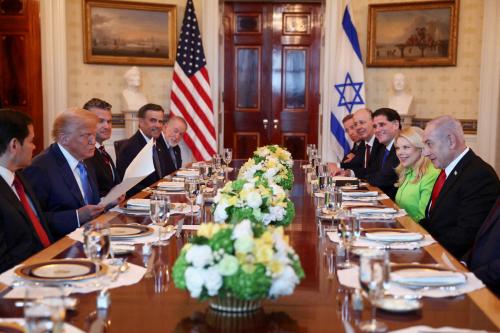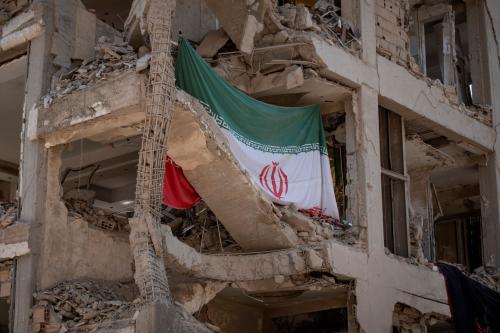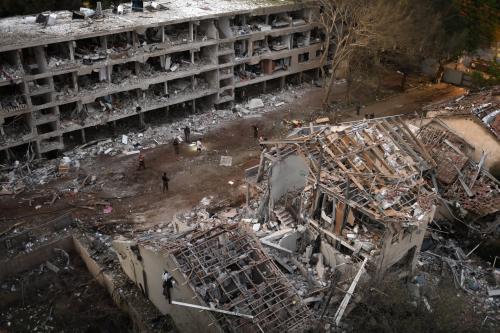This week marks the fifteenth anniversary of a violent crackdown on student protests at Tehran University. It was an event that shook Iran, rattling the nascent reform movement and reconfirming the utility of repression for the sentinels of the theocratic system. The forces that sparked the upheaval and shaped the regime’s response continue to haunt Iran, whose current president — elected only a year ago with the fervent support of students and reformists — is the same man who advocated and helped authorize the violence against their ranks in 1999.
Background to Iran’s Upheaval
The events of July 1999 began with the closure of the path-breaking reformist newspaper Salaam, for its revelations about an Intelligence Ministry terror campaign against dissidents. The closure came only days after the parliament’s ratification of a regressive new press law. Student groups organized protests on university campuses in Tehran and several other Iranian cities.
On July 9, or 18 Tir by the Iranian calendar, security forces raided a Tehran University dormitory to break up the demonstrations. The ensuing violence devastated the reform movement’s popular base, especially the student leadership. Fifteen hundred students were arrested, hundreds were injured, and several killed. The dormitory raid only fueled the fire, as thousands of young Iranians took to the streets of Tehran and other cities. Rioting and street fights among protestors and hard-line thugs ensued. It was the most severe and sustained civil violence since the 1979 revolution, and the first time that unrest had touched the heart of Tehran, the country’s political nerve center.
Mohammad Khatami, the reformist cleric whose symbolic bid for the presidency had produced a surprise upset victory two years earlier, made a futile bid to steer a middle course. Khatami decried the upheaval, expressed sympathy with the students, but appealed for the protests to end and offered only token gestures of official remorse. Khatami’s unwillingness to personally champion his most dedicated constituency bred frustration with the man and the movement, whose trademark prudence appeared little more than cowardice.
For his part, Ayatollah Ali Khamenei — who as supreme leader holds ultimate authority in the Islamic Republic — briefly struck a slightly softer tone, calling the police assault on the dormitory “this bitter incident [that] has broken my heart” but with characteristic paranoia, also inveighed against the CIA and what he described as “hidden hands behind the scenes directing this.”
Rouhani’s Role in the July 1999 Repression
Both leaders’ themes were echoed by Hassan Rouhani, then deputy speaker of Iran’s parliament and secretary of the Supreme National Security Committee. Rouhani was one of the head-liners at a well-scripted counter-demonstration organized by the regime one week after the dormitory raid. To a large, enthusiastic and well-compensated crowd, Rouhani inveighed against the protests, calling the organizers “bandits and saboteurs” and promising that Tehran would “resolutely and decisively quell any attempt to rebel.”
His pledge that the protest leaders would be charged with mohareb (enemy of God) and mofased (corrupt on earth) – crimes punishable by death in the Islamic Republic – drew some of the first international press attention for the then little-known lawmaker. However, he also reiterated promises to investigate the dormitory raid and lauded the “outstanding role” of students in Iran’s revolutionary history.
Rouhani was not the only Iranian official who achieved newfound prominence during the crisis. Also notable during this episode was the role of the Revolutionary Guard and senior military commanders, who issued an unprecedented warning to Khatami. Like Khamenei, the commanders saw the episode as “the footprints of the enemy in the aforementioned incidents and we can hear its drunken cackle.” The injunction — which was signed by, among others, current Tehran mayor and leading 2013 presidential contender Mohammad Baqr Qalibaf — admonished Khatami that “our patience has run out. We cannot tolerate this situation any longer if it is not dealt with.” The threat of military intervention proved a harbinger of things to come, as the Revolutionary Guard transformed into a political and economic powerhouse.
July 1999 marked a turning point, although that was not immediately obvious. Initially, the reform agenda did not appear to be handicapped by the events. The stock exchange merely hiccoughed in response, and the largest British trade delegation since the revolution arrived in Iran just a few weeks later. Khatami continued his efforts to promote change from within the system, and many reformist leaders saw the episode as a cautionary tale about the potential for aggressive tactics to backfire.
The Legacy of Iran’s Student Protests
Ultimately, however, the July 1999 upheaval confirmed for many of Iran’s highly politicized youth the fundamental inadequacy of the reform movement itself and the sheer impossibility of advancing gradual moderation of an absolutist system. This sense of despair left a lasting rift among reformist activists themselves, as well as between the population and the movement’s leadership. For the hard-liners, the events of July 1999 revealed that the reformists’ moderation represented their Achilles’ heel, which encouraged the increasing forcefulness of their repression.
In the decade and a half that has passed, the country’s challenges have intensified and its politics have become more polarized. When the furies reemerged a decade later, after the implausible 2009 reelection of Mahmoud Ahmadinejad, the street protestors numbered in the hundreds of thousands, in cities as well as small villages around the country, and the divisions splintered the establishment itself. Once again, Iran’s hard-liners turned to violence and intimidation, quashing the uprising but failing to squelch the aspirations of the Iranian people.
Rouhani was never a reformist, either by philosophy or political affiliation, but the rise and fall of his prospects — and more pointedly, the nation’s fortunes — since July 1999 has surely afforded him new insight into the dangers of unrestrained hard-line rule. The specter of renewed internal unrest looms large as the backdrop to his efforts to achieve a diplomatic resolution of the nuclear crisis. Still, his restraint, or worse, in advancing a domestic agenda that is equally ambitious as his diplomatic efforts raises questions about whether Rouhani can prove any more successful in tempering his citizens’ expectations than the reformists themselves did.
The Brookings Institution is committed to quality, independence, and impact.
We are supported by a diverse array of funders. In line with our values and policies, each Brookings publication represents the sole views of its author(s).




Commentary
Fifteen Years After the 18th of Tir: The Legacy of Student Protests That Shook Iran
July 10, 2014